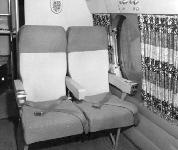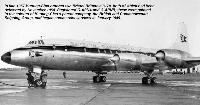Фотографии
-
In February 1955 a subsidiary, Hunting-Clan African Airways, was formed to operate freight and passenger flights from Salisbury to various points in Rhodesia and Nyasaland. Two Douglas Dakotas were used on the tourist flights between Salisbury, where this photo was taken, and Vilanculos (in Mozambique) and Johannesburg.
Самолёты на фотографии: Douglas DC-3 / C-47 Skytrain/С-53 Skytrooper / Dakota - США - 1935
-
The tail of one of Hunting-Clan’s pair of Douglas DC-6s spikes an (almost) gin-clear sky in Salisbury, Rhodesia, in the late 1950s.
Самолёты на фотографии: Douglas DC-6 / C-118 Liftmaster - США - 1946
-
One of the two Hunting-Clan DC-6As at Salisbury in 1959. Although the Yorks had provided sterling service on the Safari and Africargo routes, the pressurised DC-6 was a far more modern proposition and represented a major step forward for the airline.
Самолёты на фотографии: Douglas DC-6 / C-118 Liftmaster - США - 1946
-
Регистрационный номер: G-APNO [2] At Heathrow on August 7, 1958, Hunting-Clan took delivery of G-APNO, the first of a pair of Douglas DC-6As (the second, G-APNP, arrived on September 11). Like the Yorks they replaced, these were used mainly for cargo services, but could also be converted for passenger use. The DC-6s entered “Africargo” service on December 14, 1958.
Самолёты на фотографии: Douglas DC-6 / C-118 Liftmaster - США - 1946
-
Регистрационный номер: G-APNO [2] DC-6A G-APNO undergoes maintenance at Salisbury Airport, Rhodesia - one of the points served by the airline's "Colonial Coach" services. Both of the company’s DC-6s were transferred to British United Airways when Hunting-Clan merged with Airwork Services in 1960. Both DC-6s went to Balair in 1969 and operated in Biafra during the Nigerian Civil War, G-APNP crashing on approach to Uli Airport in May that year.
Самолёты на фотографии: Douglas DC-6 / C-118 Liftmaster - США - 1946
-
Регистрационный номер: G-ANRT [2] Vickers Viscount 732 G-ANRT, seen here at Salisbury, Rhodesia (now Harare, Zimbabwe), in 1958, was one of three ordered by Hunting-Clan in 1953. The company was the first British independent airline to place an order for turboprop aircraft, although all three were leased to Middle East Airlines in 1955, and did not fly with Hunting-Clan until September 1957.
Самолёты на фотографии: Vickers Viscount - Великобритания - 1948
-
Регистрационный номер: G-APTC Viscount 833 G-APTC at one of the Safari Service stops. Following the 1960 creation of British United Airways the former Hunting-Clan Viscounts continued to operate on the Safari routes until they were replaced by Britannias in October 1961. The Viscounts were transferred to trooping flights from Gatwick to RAF bases in West Germany.
Самолёты на фотографии: Vickers Viscount - Великобритания - 1948
-
Регистрационный номер: G-ANRT [2] A superb photograph of Viscount 732 G-ANRT at Salisbury. The airport was officially opened on February 5, 1957, although it had been used by airline traffic extensively for the previous six months. On July 1, 1960, Hunting-Clan and its subsidiaries were officially merged with those of Airwork to form British United Airways, based at Gatwick.
Самолёты на фотографии: Vickers Viscount - Великобритания - 1948
-
Angela Waller (at left) awaits the next group of passengers with a colleague. When the Viscounts entered Hunting-Clan service in 1957 a second air hostess was added to the crew - although, being a veteran of the single-hostess Viking and York Safari Services, Angela was regarded as a senior air hostess.
Самолёты на фотографии: Vickers Viscount - Великобритания - 1948
-
Регистрационный номер: G-APTB With sunlight glinting off its polished-metal upper surfaces, Viscount 833 G-APTB shows off its new Hunting-Clan colours in the summer of 1959. Three 833s, fitted with higher-powered Dart engines for hot and high conditions, were introduced on Safari services from July 1959.
Самолёты на фотографии: Vickers Viscount - Великобритания - 1948
-
The ‘‘stew’s view” - passengers await a demonstration flight from Eastleigh Airport, Nairobi, aboard Viscount G-ANRR in 1957. The first of Hunting-Clan’s Viscounts, this aircraft crashed at Frimley in Surrey during a test flight on December 2, 1958, killing all five crew members aboard.
Самолёты на фотографии: Vickers Viscount - Великобритания - 1948
-
Hunting-Clan hostess Joyce Darbyshire, who joined the airline the same day as the author, serves refreshments aboard a Viscount. Safari services initially operated with only one hardworking hostess.
Самолёты на фотографии: Vickers Viscount - Великобритания - 1948
-
Fully adjustable, the seats of Hunting-Clan’s coach service Viscount afforded unsurpassed views from the type’s much-celebrated generously-proportioned oval windows. Note the company’s crest above the seats.
Самолёты на фотографии: Vickers Viscount - Великобритания - 1948
-
Регистрационный номер: G-APNA In late 1957 Hunting-Clan ordered two Bristol Britannia 317s, both of which had been delivered by November 1958. Registered G-APNA and G-APNB, these were painted in the colours of Hunting-Clan’s parent company, the British and Commonwealth Shipping Group, and began commercial services in January 1959.
Самолёты на фотографии: Bristol Britannia / Type 175 - Великобритания - 1952
-
Регистрационный номер: G-AMXM, MW323, OD-ADM Hunting-Clan Avro York G-AMXM at Heathrow on September 18, 1957. Formerly MW323 in RAF service, this York was one of six acquired by the airline, two of which, G-AMVY and G-AMVZ, never entered service and were scrapped. The Yorks were used mainly for Hunting-Clan's "Africargo" services, but were often used on part-cargo, part-passenger services on the "Safari" routes.
Самолёты на фотографии: Avro York / Type 685 - Великобритания - 1942
-
Регистрационный номер: G-AGRW The Vickers Viking made up a large part of the Hunting-Clan fleet, the airline acquiring a total of 13, although one was for spares use only. This example, G-AGRW, originally flew with BEA as Vagabond, and is seen here at Heathrow on November 12, 1954.
Самолёты на фотографии: Vickers Viking / Valetta - Великобритания - 1945
Статьи
- -
- A.Harris - Under Development
- A.Waller - A Flying Safari
- B.Hales-Dutton - A Day of Triumph and Tragedy
- B.Lindwall - Mosquito vs Bull: Fliying the J 30 in Flygvapnet service
- D.Menzies - "A Very Audible Remark..."
- E.Brown - Big Cat Diary
- F.Merriam - Early Days at Eastchurch /Echoes from Dawn Skies/ (1)
- G.Alegi - Secondo's Slow Burner: Campini, Caproni and the C.C.2
- G.Ellis - Hunting the Lion of Afrika
- G.Skillen - Terminal Velocity
- H.Carter - Fit for the King
- J.Forsgren - Sweden's midnight Mosquitoes
- P.Davidson - Off the Beaten Track...
- P.Jarrett - Lost & Found
- R.Lezon - Reimar's little Ray of Sunshine
- R.Simpson - Elegant Imperfection
- R.Tisdale, A.Vercamer - Before & After















